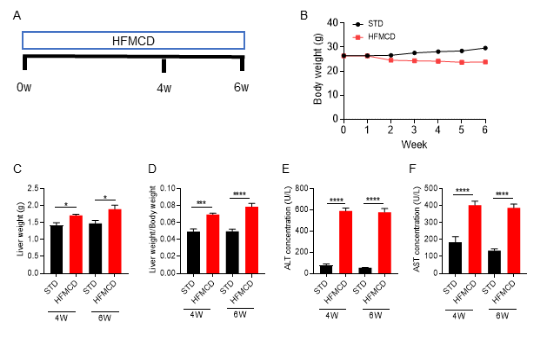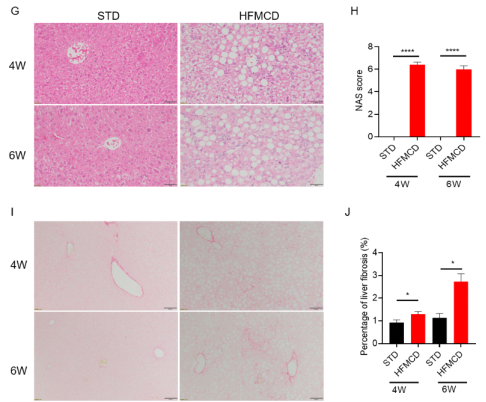Nonalcoholic fatty liver disease (NAFLD) is a disease in which fat accumulates excessively in the liver. This fat accumulation is not caused by heavy alcohol consumption. Non-alcoholic steatohepatitis (NASH) is one type of NAFLD. In addition to liver fat accumulation, there are pathological changes of hepatitis, hepatocyte injury, fibrosis and liver scar formation, which may lead to cirrhosis or liver cancer. The mechanism of NASH progression remains unclear, and effective treatments are still lacking.
The clinical symptoms of NASH are quite complex and include obesity, insulin resistance, steatohepatitis, hepatocyte ballooning, and fibrosis according to the disease process. NASH models often used in preclinical experiments are genetic animal models, diet-induced animal models, and animal models constructed by combining genetics with diet-inductioned. However, it is difficult to mimic all the pathogenetic features of human diseases in a short period of time.
To understand the pathogenic mechanisms underlying the development and progression of NASH and to develop innovative therapies, we developed several mouse models of different stages of NASH pathogenesis.
- Western diet (WD): Dietary components include high fructose and high cholesterol, and this diet-induced NASH model develops obesity, impaired glucose tolerance and hepatic steatosis.
- High-fat methionine-choline-deficient diet (HFMCD): The diet contains 60 kcal% fat, and is deficient in methionine and choline. , and this diet-induced NASH model shows increased liver injury, hepatic steatosis, and fibrosis accompanied by increased NAS scores.
- Carbon tetrachloride (CCl4) injection: causes significant liver inflammation and fibrosis. Because Although each the perfect model has is slightly different phenotypes,obtained, it is a good choice to select the appropriate model currently available according to the characteristics of the target.
Comparison of diet and chemical induced NASH mouse models
|
• Features |
• WD |
• HFMCD |
CCl4 |
|
• Obesity |
• + |
• - |
- |
|
• Dyslipidemia |
• + |
• TG TC Decrease |
- |
|
• Hepatomegaly |
• + |
• + |
+ |
|
• Hepatic transaminases |
• + |
• + |
+ |
|
• Steatosis |
• + |
• + |
- |
|
• Inflammation |
• Minor |
• + |
+ |
|
• Fibrosis |
• Minor |
• + |
+ |
|
• Induction time (weeks) |
• 12-24 |
• 4-8 |
0.5-4 |
High-fat methionine-choline-deficient diet (HFMCD) -induction of NASH in mice
The HFMCD diet is a classic dietary model for NASH. Although the diet containsed 60 kcal% fat, it lacksed methionine and choline. Both methionine and choline can promote the delivery of fat from the liver through the blood in the form of phospholipids, improve the utilization of fatty acids in the liver, and prevent the abnormal accumulation of fat in the liver.


A model of NASH induced by a high-fat methionine-choline-deficient diet (HFMCD). Wild-type C57BL/6J mice were randomly divided into four groups and given a standard diet (STD) and a high-fat methionine-choline-deficient (HFMCD) diet and fed for 4 weeks and 6 weeks to detect various parameters. (Fig. A) HFMCD-induced NASH model protocol diagram; (B) mouse body weight; (C) liver weight; (D) ratio of liver weight to body weight; (E-F) serum ALT and AST concentrations; (G-H) HE staining and NAS score of liver tissue sections; (I-J) Sirius red staining of liver tissue sections and quantification statistics of the degree of liver fibrosis. The results showed that compared with the HFMCD-induced STD group, the liver weight was significantly increased; the serum ALT and AST concentrations were significantly increased. In addition, ; HE staining of liver tissue sections showed extensive hepatocyte steatosis, ballooning degeneration and intralobular inflammation; Sirius red staining of liver tissue showed significant liver fibrosis. The above results indicate that HFMCD induction can successfully establish a mouse model of NASH. Data are mean ± SEM, n = 5.
References:
1. Hernandez-Perez, E., Leon Garcia, P.E., Lopez-Diazguerrero, N.E., Rivera-Cabrera, F. & Del Angel Benitez, E. Liver steatosis and nonalcoholic steatohepatitis: from pathogenesis to therapy. Medwave 16, e6535 (2016).
2. Tsuchida, T., et al. A simple diet- and chemical-induced murine NASH model with rapid progression of steatohepatitis, fibrosis and liver cancer. J Hepatol 69, 385-395 (2018).
3. Farrell, G., et al. Mouse Models of Nonalcoholic Steatohepatitis: Toward Optimization of Their Relevance to Human Nonalcoholic Steatohepatitis. Hepatology 69, 2241-2257 (2019).









